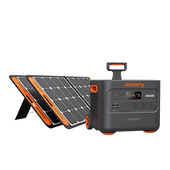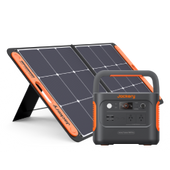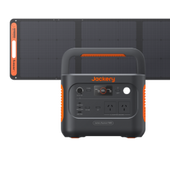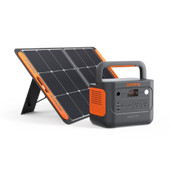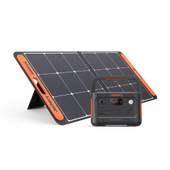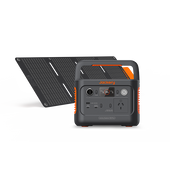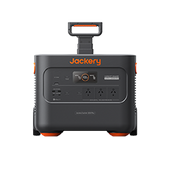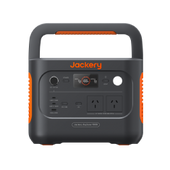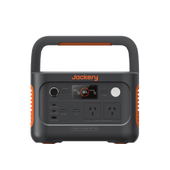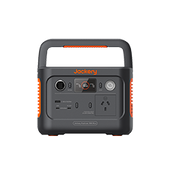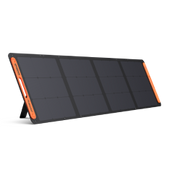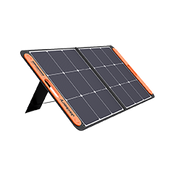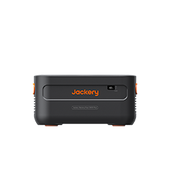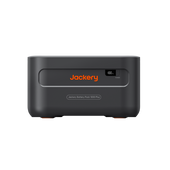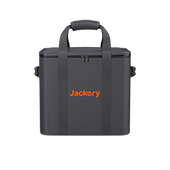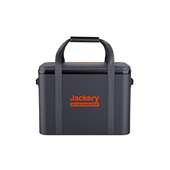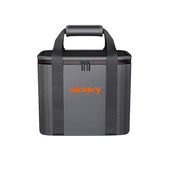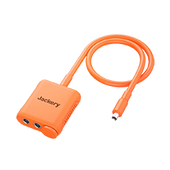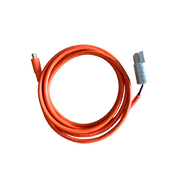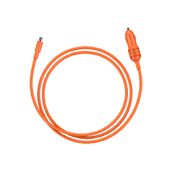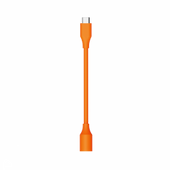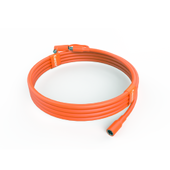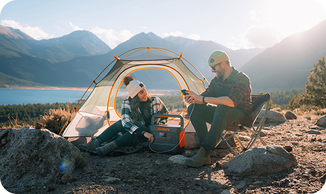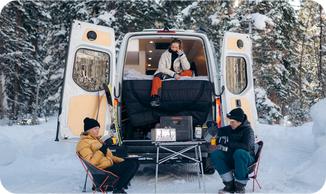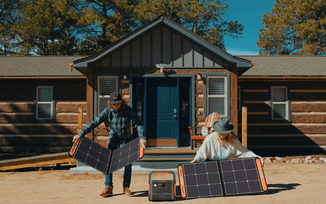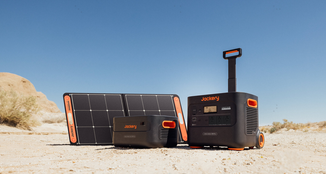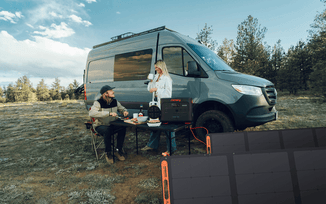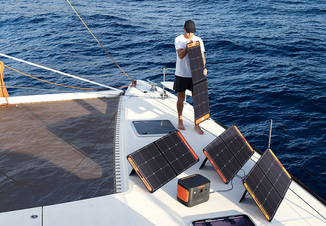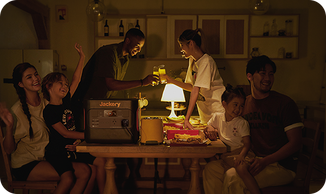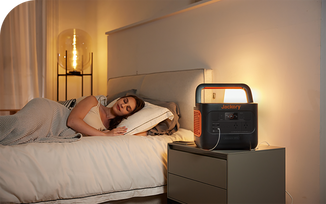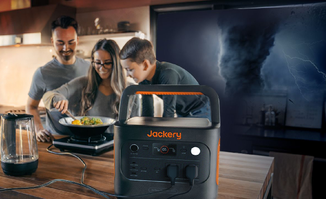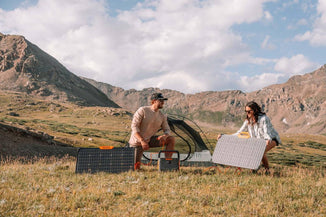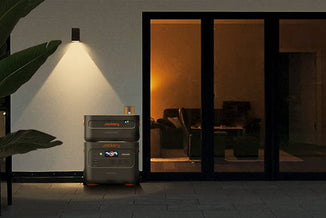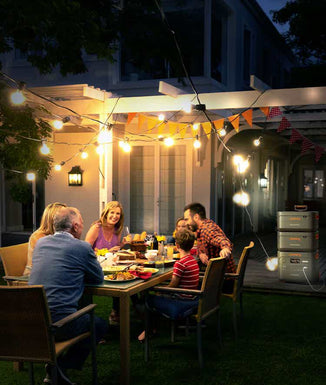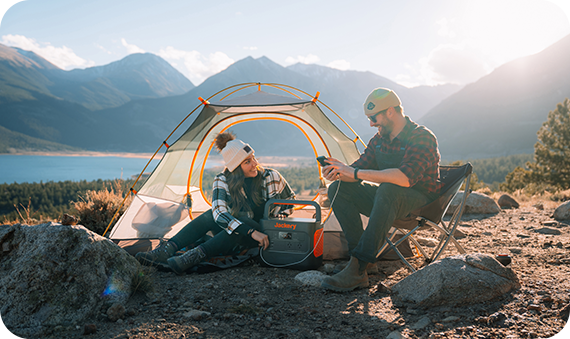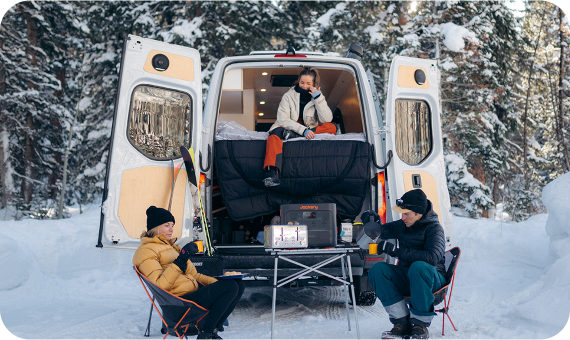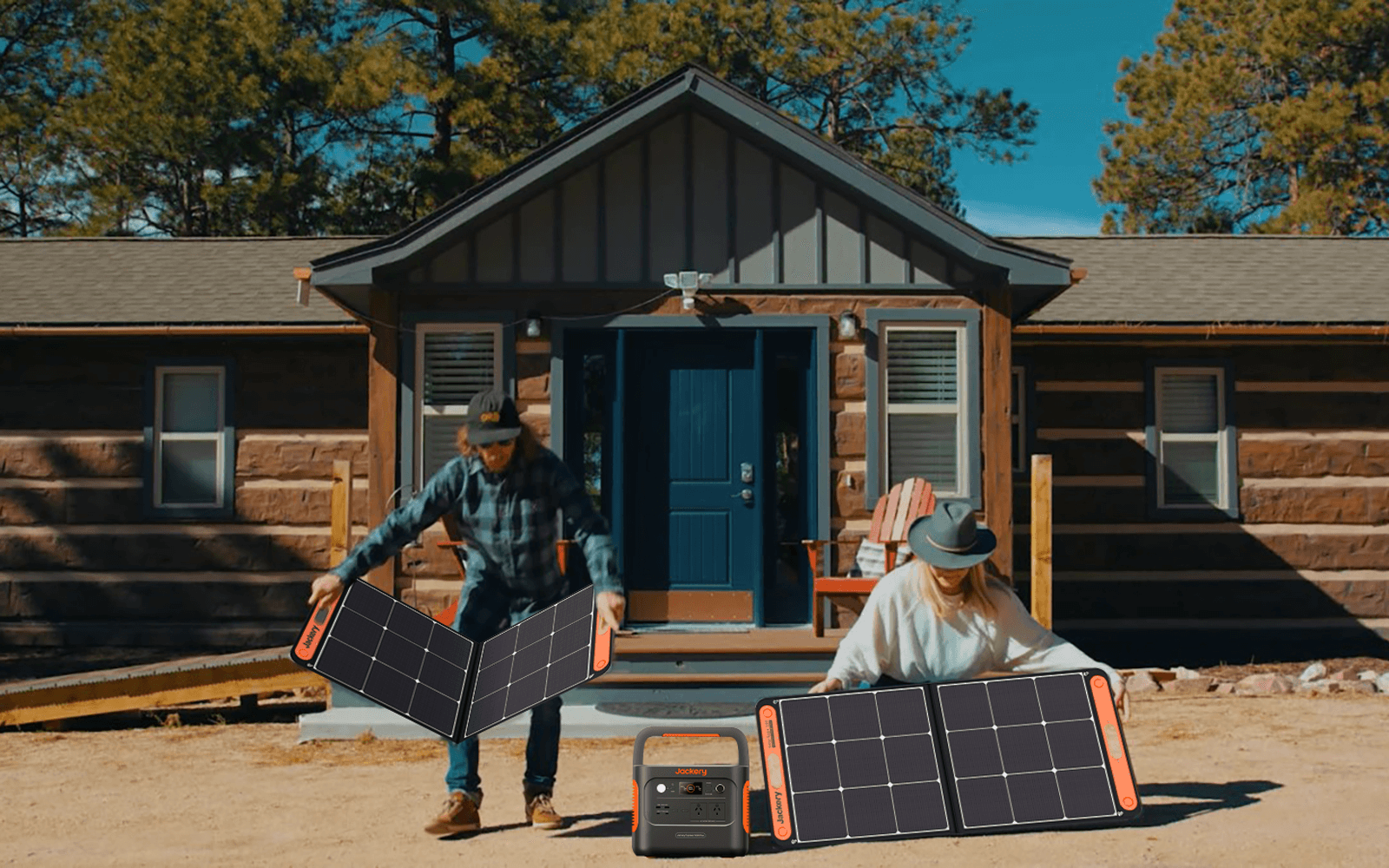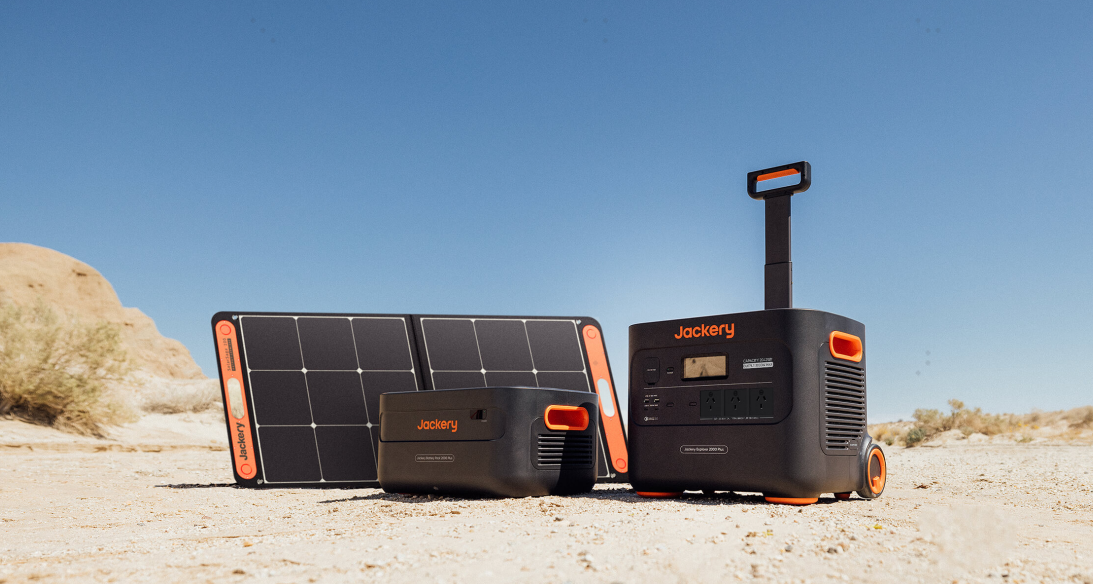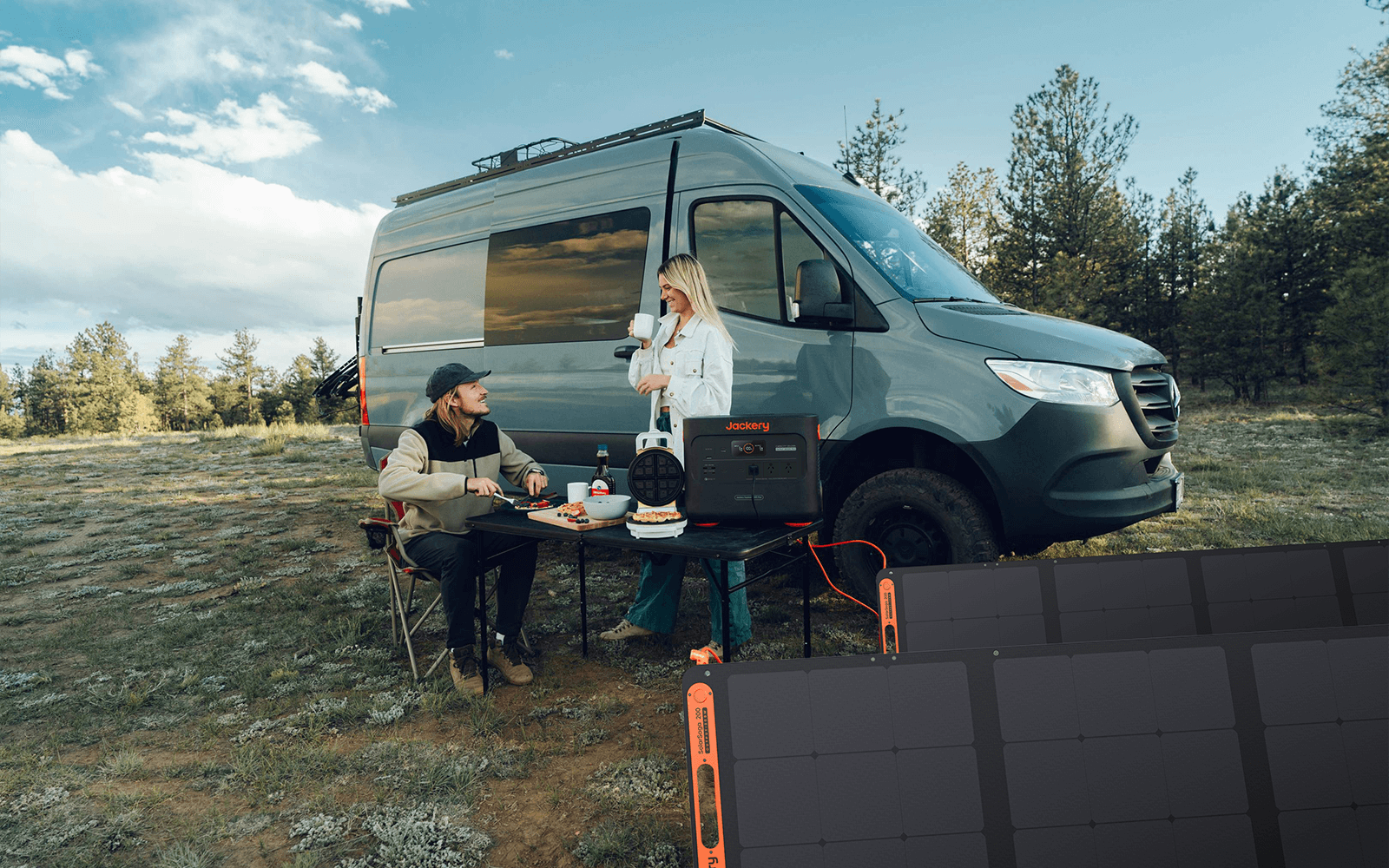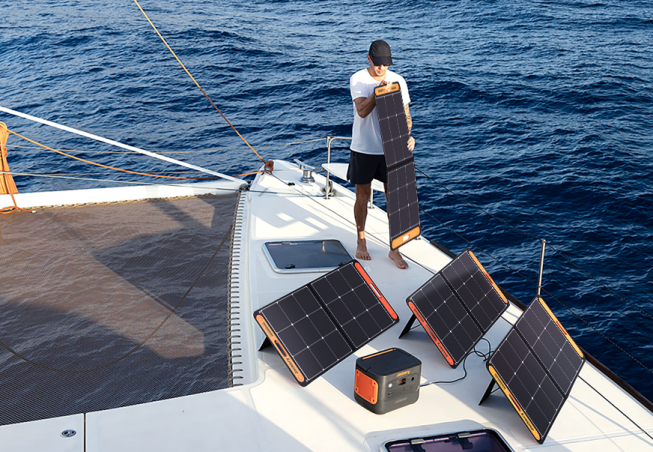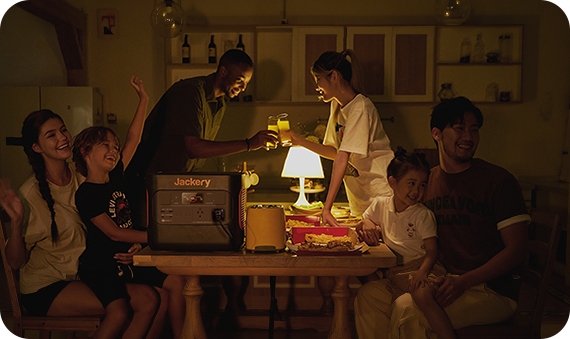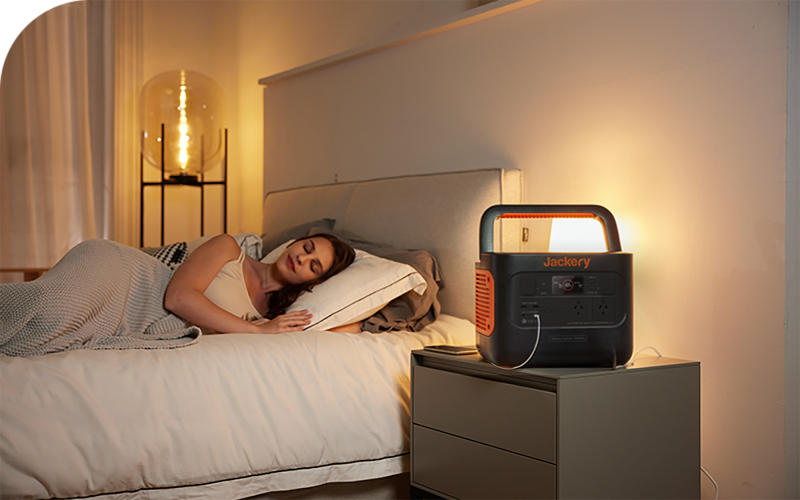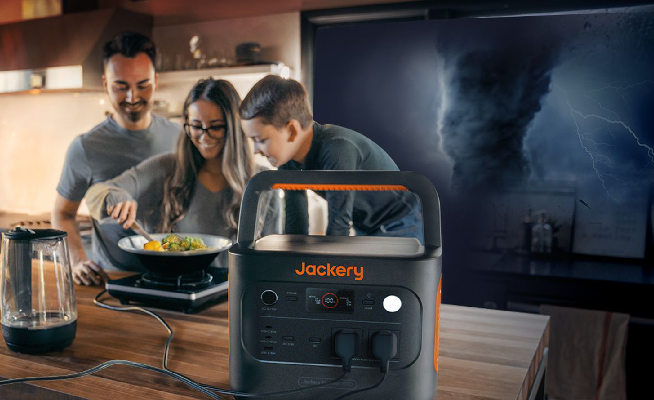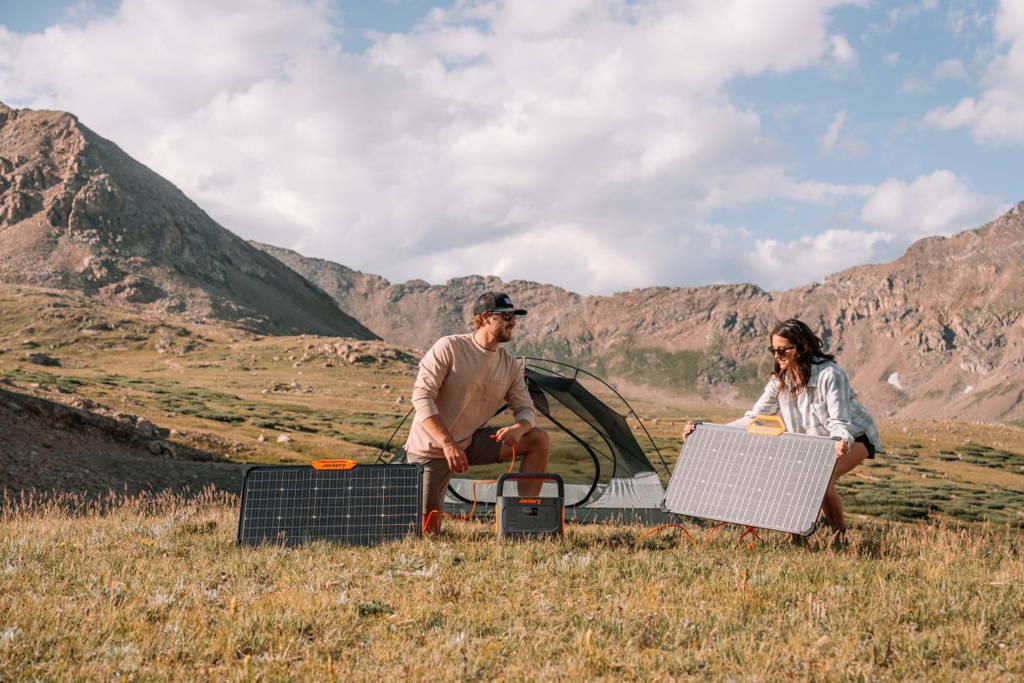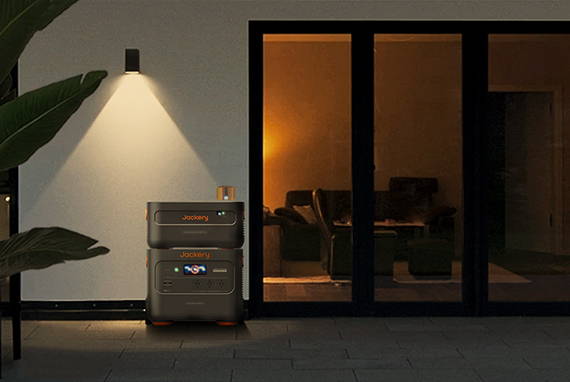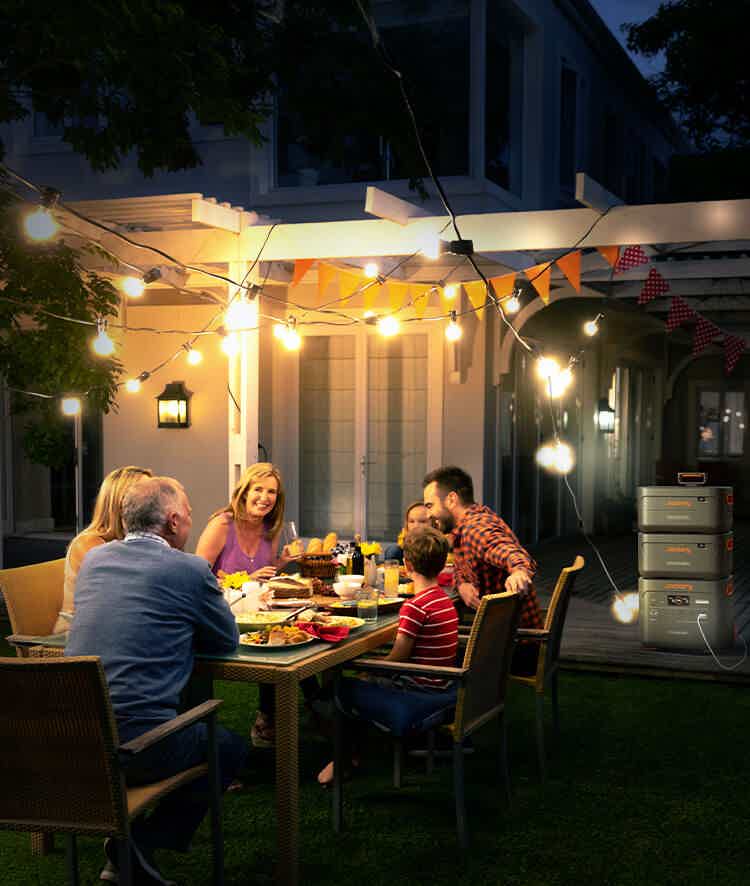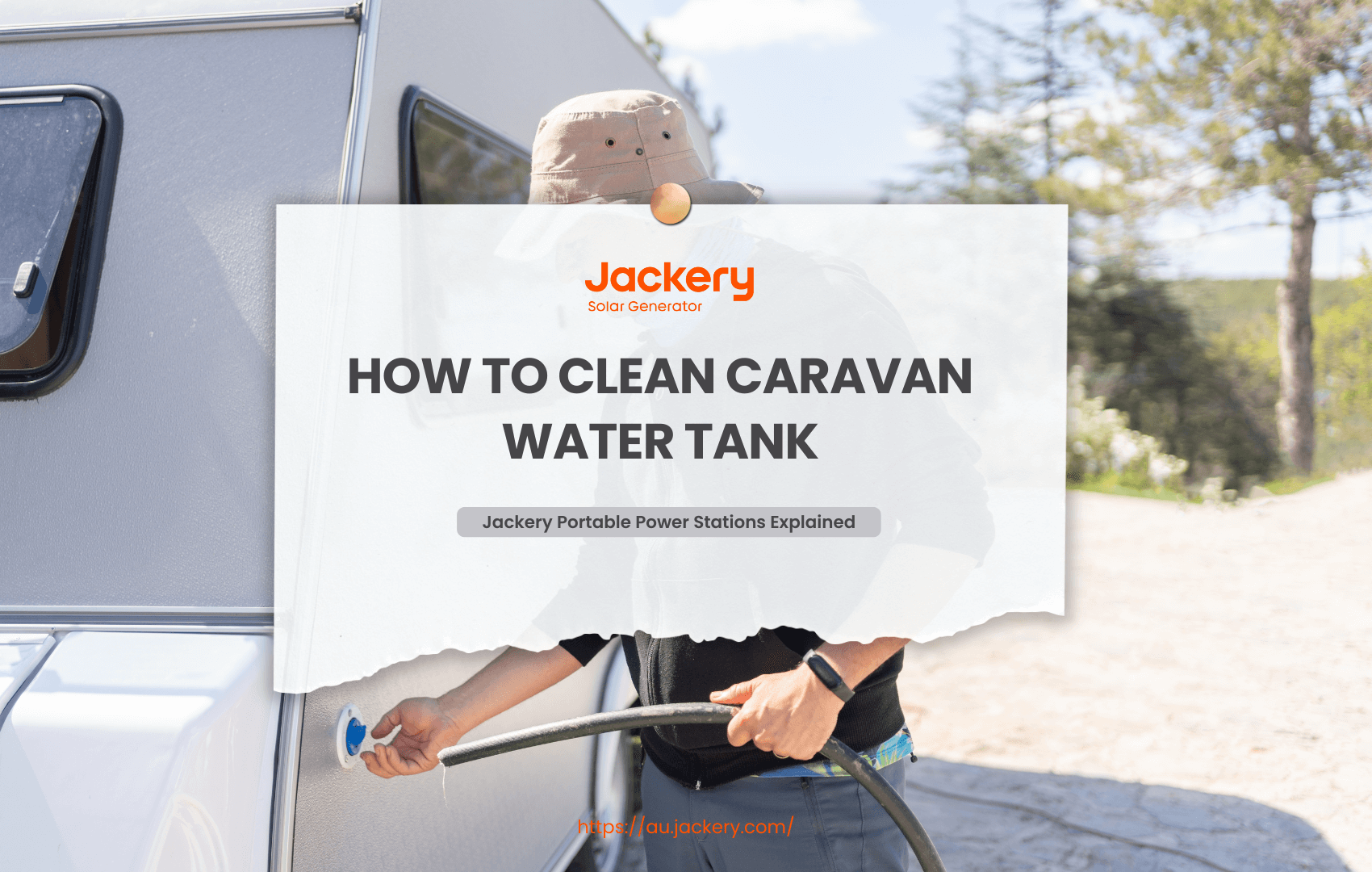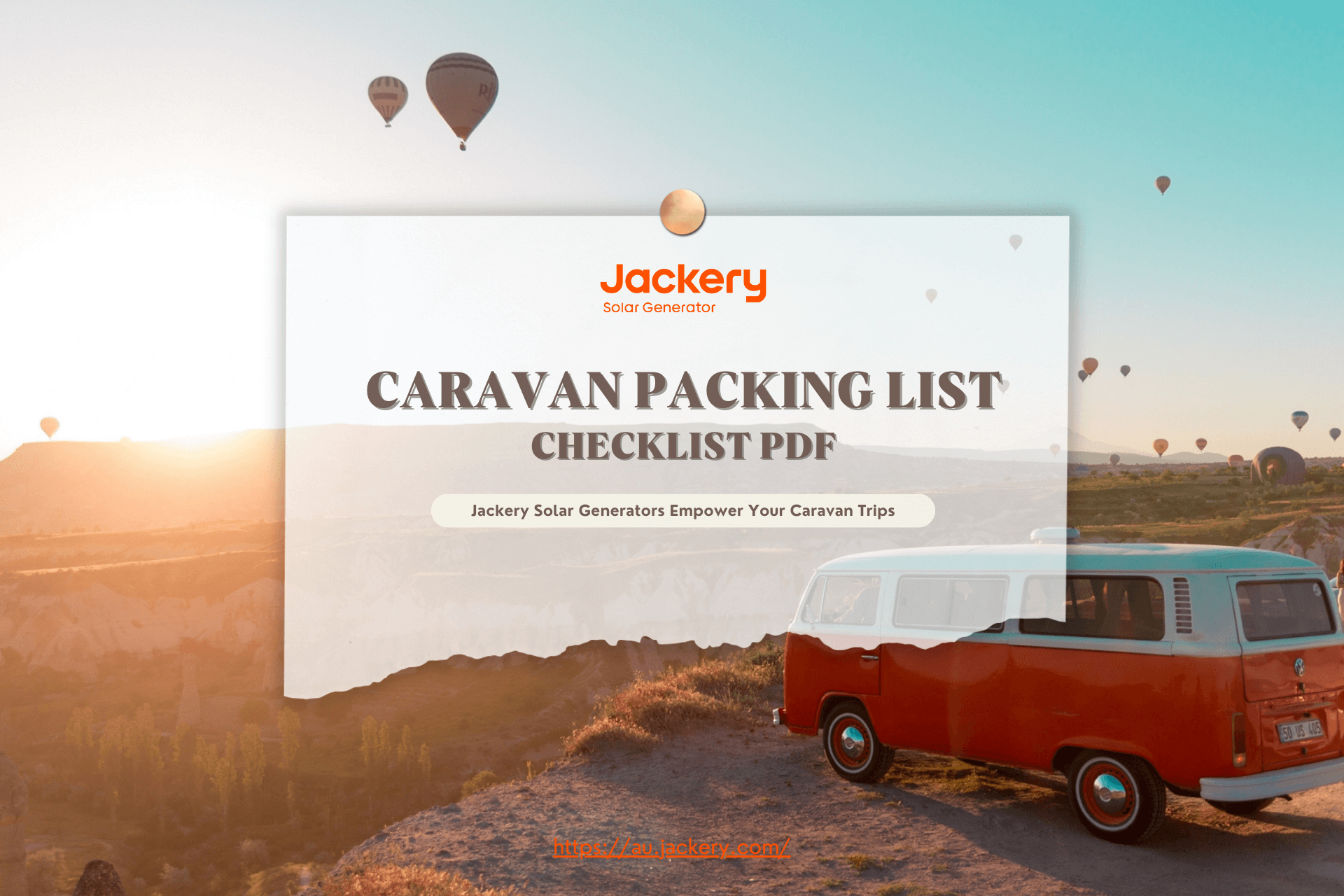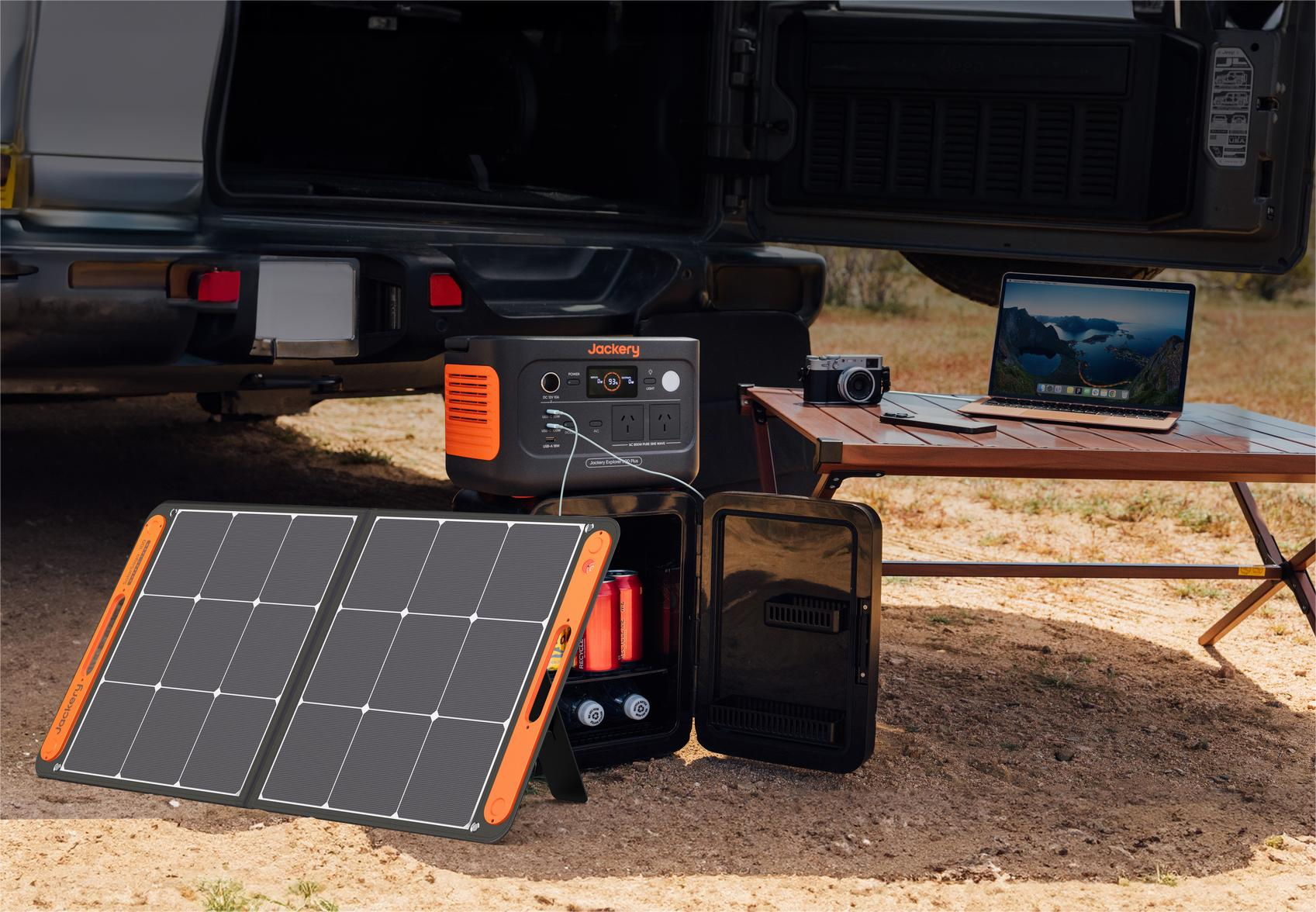|
Key Takeaways: |
|
- You should clean your caravan water tanks every 3 to 6 months, depending on usage and water quality. - Always use food-grade hoses and potable water sources to prevent chemical contamination. - Regularly cleaning fresh, grey, black, and hot water tanks prevents bacterial buildup and unpleasant odours. - Hot water heater tanks should be flushed and descaled every six months to maintain efficiency. Draining tanks when the caravan is not in use prevents bacteria and algae growth. - We recommend Jackery Explorer 1000 v2 portable power station to power your caravan appliances, even the water pump. |
Why Would You Clean a Caravan Water Tank?
Camping is an experience, whether you have a caravan or camper trailer that can carry a lot of water through water tanks or just jerry cans.
The number of transportable water containers that can be installed in a caravan, ranging from tanks for carrying fresh water to tanks for carrying wastewater or grey water until it can be securely disposed of, frequently surprises those who are relatively new to the lifestyle.
It's true that you might easily bring litres and litres of water with you when travelling. Along with a wide selection of caravan water tanks, there are handy accessories that improve your ability to get water when needed. Finally, the objective is to travel widely (and with great enjoyment) without losing access to clean, fresh water through a dependable water system.
In actuality, organic stuff, including dangerous bacteria, biofilm, fungi, and viruses, accumulate in these water tanks, which can interfere with your system's longevity and flow rate and endanger your health. Because caravans are frequently not utilised for long periods, it is crucial to safeguard your drinking water and cooking water while you are moving.

How to Clean the Different Types of Caravan Water Tanks
Maintaining clean water tanks in your caravan is critical to ensuring safe and enjoyable trips around Australia. Regular cleaning eliminates pollution, unpleasant odours, and other health hazards. The following is a detailed guide to cleaning several caravan water tanks: fresh water, grey water, black water, and hot water heater tanks.
Fresh Water Tanks (Drinking Water Supply)
Fresh water tanks provide clean water for drinking, cooking, and cleaning in your caravan. These tanks can build up dirt, bacteria, and algae over time, especially if left unused or filled with questionable materials. Regular cleaning ensures that the water is safe and delightful to use.
Cleaning Steps:
Step 1 Drain the Tank: Completely empty the tank to remove residual water.
Step 2 Prepare a Cleaning Solution: Use a cleaning solution designed explicitly for caravan
water tanks and safe for potable water systems. Alternatively, you can use home bleach at a ratio of 12ml of liquid bleach (4% accessible chlorine) per 100 litres of tank capacity.
Step 3 Fill and Soak: Fill the tank with the cleaning solution and let it sit for several hours to disinfect.
Step 4 Flush the System: Open all taps and run the solution through the plumbing to clean the entire system.
Step 5 Rinse Thoroughly: Drain the tank and replace it with clean water. Run water through all taps to remove any residual cleaning solution. Repeat until the water is clear and odourless.
Step 6 Regular Maintenance: Clean your fresh water tank every 6 to 12 months, or more often, if the water quality is questionable.
Grey Water Tanks (Sink and Shower Wastewater)
Grey water tanks collect wastewater from sinks, showers, and washing machines. While grey water is not as deadly as black water, it can emit unpleasant odours and serve as a breeding ground for bacteria if not treated properly. In addition, inappropriate disposal may result in environmental fines in Australia.
Cleaning Steps:
Step 1 Empty the Tank: Dispose of the grey water at an approved disposal site.
Step 2 Flush the System: Fill the tank with a water solution and a specialised greywater tank cleanser. Allow it to sit for the necessary time to break down residues.
Step 3 Scrub the Interior: If accessible, scrub the interior walls to remove any buildup.
Step 4 Rinse Thoroughly: Rinse the tank with clean water to remove any remaining cleaning solution.
Step 5 Maintain Regularly: Clean the grey water tank after each trip or every two weeks if used frequently to avoid smells and obstructions.
Black Water Tanks (Toilet Waste)
Black water tanks in caravans and RVs hold sewage and toilet waste. Regular cleaning is necessary to avoid clogs, reduce odours, and preserve hygiene. Using proper cleaning solutions helps to protect the tank's seals and components.
Cleaning Steps:
Step 1 Empty at Designated Dump Points: Always dispose of black water at approved sewage disposal sites.
Step 2 Rinse the Tank: Use a tank rinser or a hose to flush out the tank, removing any residual waste.
Step 3 Add Treatment Chemicals: After cleaning, add appropriate black water tank treatment chemicals to help break down waste and control odours.
Step 4 Regular Maintenance: Regularly monitor and maintain the tank to prevent buildup and ensure proper functioning.
Hot Water Heater Tanks
Mineral deposits and silt can build up in hot water heater tanks over time, lowering performance and potentially damaging them. Flushing and descaling must be done regularly to ensure optimal performance and extend the system's lifespan.
Cleaning Steps:
Step 1 Turn Off Power and Water Supply: Ensure the heater's power (electricity or gas) and water supply are turned off.
Step 2 Drain the Tank: Attach a hose to the drain valve and empty the tank completely.
Step 3 Flush Out Sediment: Briefly open the cold water supply to stir up and flush out any remaining sediment.
Step 4 Inspect the Anode Rod: Check the anode rod for corrosion and replace it if necessary. The anode rod helps prevent rust inside the tank.
Step 5 Refill and Restore Power: Close the drain valve, remove the hose, and refill the tank. Once full, restore power to the heater.
Step 6 Regular Maintenance: It's recommended to flush your hot water system every six months to prevent sediment buildup and maintain efficiency.
Tips and Tools for Cleaning Caravan Water Tanks
Maintaining and cleaning your caravan's water tanks is necessary to ensure safe and healthy travel. The following sections cover crucial safety considerations, the tools you'll need for the job, and helpful recommendations for keeping your tank water fresh for each trip.

Safety Precautions for Cleaning Caravan Water Tanks
When cleaning caravan water tanks, prioritise your health and the cleanliness of your potable water supply. Always disconnect the water pump and any electrical connections to the tank before starting. Use food-grade cleaning solutions like diluted white vinegar or commercially available caravan tank cleaners, ensuring thorough rinsing with fresh water multiple times to remove all traces of the cleaning agent.
Avoid using harsh chemicals or bleach that could contaminate the system and make the water unsafe for consumption. After cleaning, sanitise the tank with a mild solution if desired, followed by another thorough rinsing.
Wear Personal Protective Equipment (PPE): Always use strong rubber gloves to protect your hands from cleaning agents and contaminants and safety goggles to protect your eyes from splashes, especially when working with chemicals like bleach.
Ensure Proper Ventilation: When cleaning your caravan water tanks, make sure you work in a well-ventilated area to avoid breathing cleaning chemicals.
Use Appropriate Cleaning Agents: Only use potable water-safe cleaning solutions, such as food-grade cleansers or household bleach, at the proper dilution ratio to prevent harming your tanks or jeopardising water safety.
Avoid Mixing Chemicals: Never mix different cleaning products because combining chemicals such as bleach and ammonia can produce hazardous gases that are harmful to your health.
Dispose of Wastewater Responsibly: Always empty grey and black water tanks at certified disposal sites to prevent environmental harm and comply with Australian rules.
Check for Leaks and Damage: Before and after cleaning your tanks, look for cracks, leaks, or damaged fittings to keep your water system safe and effective.
Follow Manufacturer Guidelines: To avoid voiding warranties or causing damage, always read and follow the manufacturer's cleaning and maintenance instructions for your caravan and water tanks.
Essential Tools for Cleaning Caravan Water Tanks
To effectively clean your caravan water tanks, a few essential tools will make the job easier and more thorough. You'll need a long-handled scrub brush to reach all interior surfaces of the tank, especially in larger models.
A submersible pump or a siphon hose will be helpful for efficiently draining the tank after each rinse. Consider having a bucket or container to collect the drained water. Additionally, a clean, food-grade hose for refilling the tank with fresh water is crucial to prevent recontamination.
Hose with Spray Nozzle: Use a garden hose with a spray nozzle to thoroughly rinse out the tanks and flush away loosened debris.
Tank Cleaning Wand or Flexible Brush: Use a specially designed tank cleaning wand or a flexible long-handled brush to reach inside the tanks and scrub away sediment and buildup.
Measuring Jug: Always use a measuring jug to accurately measure cleaning agents such as bleach, ensuring the correct concentration is used to disinfect the tank safely.
Buckets: Have a few buckets ready to mix cleaning solutions and to assist in collecting water during the cleaning process.
Wrench or Socket Set: Use a wrench or socket set if needed to loosen and remove any fittings, caps, or panels that provide access to your water tanks.
Cleaning Cloths or Sponges: Keep clean cloths or sponges on hand to wipe down external surfaces of the tanks and any fittings that need attention.
Dedicated Wastewater Tub: Prepare a separate tub specifically for collecting and temporarily holding grey or black wastewater when cleaning or emptying tanks.
Safety Equipment: In addition to gloves and goggles, consider wearing a face mask if you are using strong-smelling chemicals or working in an enclosed space.
Tips to Keep Caravan Tank Water Clean
Maintaining fresh water in your caravan tanks involves a few consistent practices. Regularly empty and refill your tank, ideally before each trip or at least every few weeks, to prevent stagnation. Always use a clean, food-grade hose and a reputable water source when refilling.

Consider using water tank purification tablets or solutions specifically designed for potable water systems in RVs and caravans, following the manufacturer's instructions carefully. Avoid leaving water in the tank for extended periods, especially in warm weather, as this encourages bacteria and algae growth.
Tip 1: Always use clean, food-grade hoses and potable water sources.
When filling your caravan's water tanks, use food-grade hoses to avoid chemical contamination, and always fill from a reliable, drinkable water source to assure safety.
Tip 2: Clean and maintain your tanks regularly.
It is critical to clean your tanks every 3 to 6 months with proper, potable-safe cleaning solutions such as diluted bleach and to assess your system for leaks or damage.
Tip 3: Install water filters and treatment systems.
Using in-line filters or full treatment systems removes sediments, chlorine, and other contaminants, making your water cleaner and extending the life of your tanks.
Tip 4: Drain your tanks when the caravan is not in use.
If your caravan is lying idle for a long time, draining the tanks prevents bacteria, algae, and mould from growing within, keeping the system fresh for your next trip.
Tip 5: Monitor water quality regularly and fix issues quickly.
Regularly testing the water and resolving plumbing issues such as leaks or faulty fittings ensures the water is safe, clean, and contaminant-free.
How Often Should You Clean a Caravan Water Tank?
Keeping your caravan's water tanks clean is essential to caravan maintenance. Clean tanks imply safe, fresh water for drinking, cooking, and washing and a significantly improved overall trip experience. But how often should you really clean your caravan's water tanks?
Most Australian experts recommend cleaning your caravan water tanks every 3 to 6 months. However, exactly how often depends on a few important factors:

Frequent Use: If you travel frequently and fill your tanks with water from various sources, you should clean them every three months. The quality of different water supplies varies, and bacteria might accumulate more quickly with continuous use.
Seasonal Use or Storage: If your caravan spends much time parked, you should still clean the tanks before and after long storage periods. Stale water can promote the growth of bacteria, algae, and unpleasant odours.
Signs of Dirty Water: If the water from your taps begins to taste, smell, or appear weird - even slightly - it's a warning that the tanks need to be cleaned right away, regardless of how long it's been since the last clean.
Important to Note: Even if you haven't used your caravan in a while, don't assume the water is still clean! If you're getting ready for a new trip, examine everything and consider completing a fast cleaning. Following a regular cleaning routine protects your health, extends the life of your water tanks, and makes your trips less stressful.
Cleaning your tanks regularly also helps maintain the overall plumbing system and ensures that your caravan is ready to go whenever you are.
Jackery Portable Power Stations for Caravans
Choosing a Jackery Portable Power Station for a caravan offers a compelling blend of convenience, eco-friendliness, and reliability for powering your adventures on the road.
Unlike noisy and fume-producing generators, Jackery power stations operate silently and produce zero emissions. This creates a more peaceful and healthy environment around your caravan, whether you're in a crowded campsite or a serene natural setting. You can enjoy the sounds of nature without the constant drone of an engine.
Jackery units are designed with portability in mind. They are relatively lightweight and often feature convenient carrying handles, making them easy to move around your caravan or take outside as needed. Setting them up is straightforward – simply charge them up and plug them into your devices.
Furthermore, Jackery Portable Power Stations come equipped with a variety of outlets, including AC outlets (for standard household appliances), USB ports (both USB-A and USB-C for charging phones, tablets, and laptops), and DC ports (for some caravan-specific accessories). This versatility allows you to power a wide range of devices essential for comfortable caravanning, even the water pump. Here, we recommend Jackery Explorer 1000 v2 for your caravan.

Jackery Explorer 1000 v2
With a robust 1500W AC output and a surge peak of 3000W, this device can support various outdoor appliances, including portable speakers, projectors, cameras, phones, etc. The device includes 100W PD Fast USB-C charging (both input and output) for efficient recharging, possesses a substantial 1070Wh capacity, and is designed in a compact size to optimise space utilisation.
The Jackery Explorer 1000 v2 Portable Power Station is engineered for mobile energy solutions. Weighing about 23.8 lbs and equipped with a compact foldable handle, it is more lightweight and portable than conventional items. Besides, it is 20% smaller and 10% lighter than mainstream products. This powerhouse conveniently fits into the back compartment for effortless storage, guaranteeing you are never without power.
Jackery's upgraded Power Station exhibits a 50% enhancement in power output compared to the previous Explorer 1000 model, with an AC output of 1500W. It charges 7.5 times faster, achieving a full charge in just 59 min through the Jackery App. The LiFePO4 battery exhibits a lifespan four times greater than conventional batteries, supporting 4,000 life cycles while maintaining over 70% of its capacity.
The Jackery Explorer 1000 v2 offers rapid charging capabilities, achieving a full charge in 60 minutes when utilised with the accompanying application. The ChargeShield 2.0 system provides 62 types of safety protection and is CE-certified. It features comprehensive fire and shock resistance to ensure quality and optimal safety.
For caravaners who enjoy boondocking or staying in locations without electrical hookups, the Explorer 1000 v2 provides a vital source of power independence. When paired with Jackery SolarSaga 200W solar panel, you can recharge the power station using solar energy, extending your off-grid stays and reducing your reliance on traditional power sources.
|
Jackery Explorer 1000 v2 Working Hours (1070Wh) |
|
|
Portable Fridge (60W) |
15H |
|
Coffee Maker (550W) |
1.5H |
|
Projector (100W) |
8H |
|
Phone (29W) |
34 Times |
|
Water Pump (60W) |
11H |
(*The working hours are only for reference; the actual working hours depend on your usage.)
FAQs
The following are the frequently asked questions about how to clean the caravan water tank.
1. What is the best cleaner for caravan water tanks?
The finest cleaner for caravan water tanks in Australia is a food-grade tank cleanser, such as Camec Tank Clean or Tank Cleen Tablet, because they are specifically intended for potable water systems and safely eliminate bacteria, algae, and smells without leaving dangerous residues. A diluted solution of household bleach (usually 1 part bleach to 4 parts water) is also commonly recommended as a DIY option, as long as it is carefully washed away afterwards.
2. Can I use vinegar to clean a caravan water tank?
Vinegar can be used to clean a caravan water tank since it is a natural, non-toxic solution that helps break down mineral deposits, remove minor smells, and inhibit bacterial development. However, vinegar is less efficient against heavy pollution than professional tank cleansers or diluted bleach. Therefore, it should be used for minor cleaning or regular maintenance rather than deep sanitisation.
3. What is the best way to clean an RV's fresh water tank?
The best way to clean an RV fresh water tank is to thoroughly empty it and then replace it with a water solution and a safe cleaning agent, such as food-grade cleanser or diluted household bleach. Allow the solution to disinfect the tank for several hours before draining it completely and flushing the system with clean water to remove any residue. Always check for leaks and fasten any fittings.
4. How do you get the plastic taste out of a caravan water tank?
To remove the plastic taste from a motorhome water tank, thoroughly flush it with a solution of water and bicarbonate of soda (baking soda), using approximately 1 cup of baking soda for every 60 litres of water. Fill the tank with the solution and let it sit for 12 to 24 hours before draining and rinsing it several times with fresh water. Using food-grade hoses and an in-line water filter can also help to avoid plastic taste in the future.
5. Can I use vinegar to clean a water tank?
Vinegar can be used to clean a water tank because it is a natural, non-toxic cleaner that eliminates light mineral accumulation, smells, and moderate germs. However, more potent cleansers such as diluted bleach or specific food-grade solutions are usually more successful for deep sanitisation, particularly in drinking water tanks.
Final Thoughts
Regular cleaning and repairing your caravan's water tanks is essential for a comfortable and pleasurable journey. By following proper cleaning procedures, using the appropriate materials, and adhering to maintenance schedules, you can safeguard your health, extend the life of your caravan systems, and enjoy fresh, clean water wherever you go.
A little work pays off, whether you're dealing with fresh water, grey water, black water, or hot water heater tanks. Always use potable-safe cleaners, monitor your water quality, and never skip tank inspections before a long journey.

